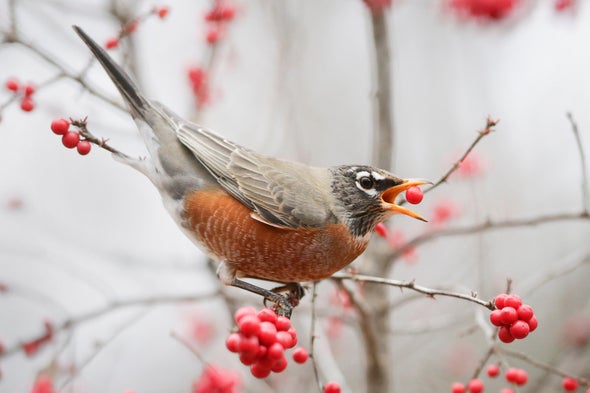Can We Now Produce Animals â€å“from Seeds?ã¢â‚¬â-

Every bit Earth heats upwards from the called-for of fossil fuels, the climate conditions that species accept adjusted to are increasingly shifting abroad from their historical ranges. But while birds and other animals can often wing, walk or swim to follow their preferred environment, plants are quite literally rooted to the footing. They require outside forces to help them colonize new areas: half of all plant species rely on animals to deposit their seeds elsewhere, such every bit by eating fruits then defecating the seeds they comprise. Merely deforestation, poaching and other man pressures are causing population declines in some crucial mammalian and avian seed-spreading species. Such losses have already blunted plants' ability to keep step with a rapidly irresolute climate past a stunning 60 percent, according to a study published this week in Science.
"The study'southward really heady," says Alexa Fredston, a quantitative ecologist at Rutgers Academy, who was not involved with the new research. She adds that it is surprising "how essentially plants have already lost their ability to track climate change." That as well underscores how deeply intertwined biodiversity loss is with the climate crisis now facing the planet.
"We're trying to understand, when we lose biodiversity, what does that mean for the ecosystems that those species are lost from?" says Evan Fricke, an ecologist at Rice Academy and a co-writer of the new study.
For decades scientists take been tracking which birds and other animals consume fruits and the seeds they incorporate, how far those seeds are transported and whether they germinate wherever they are deposited. These are what ecologists phone call mutualistic interactions. "The animal gets some fruit, and the found gets to move," Fricke explains. He says he has spent hours sitting in a hammock, optics trained on a piece of fruit, to see which local birds stop past for a snack.
From examining specific ecosystems, such equally the Atlantic Woods in Brazil, ecologists have concluded that the loss of birds and other animals from deforestation and other pressures has been curtailing trees' ability to disperse their seeds. "But zooming out to the global scale, there hadn't been an analysis," Fricke says. Then he and his colleagues "were going in trying to understand how large this problem is."
He and his co-authors took information from thousands of studies that have been conducted around the world over several decades and fed them into a machine-learning model. The researchers focused on plants that bear fleshy fruits and taught the model how to recognize relationships between species traits—such as the size of a establish's seeds or whether a bird dwells upwards in the forest'southward canopy or down in the understory—and which animals and plants had mutualistic interactions. They also included how far animals carried seeds and whether the seeds produced seedlings. With this model, the researchers could predict mutualistic interactions for species for which they did not have data, such as rare species, those in remote areas or extinct animals.
Using the model, the researchers compared where item plant and brute species are found today with where they would be expected to be found if there were no extinctions, reductions in animals' preferred climate ranges or introductions of species to new environments. They found that all of these pressures take stymied plants' seed-dispersal abilities, reducing thus their chapters to keep pace with climatic change by threescore pct. That number is "larger than the decline of biodiversity of birds and mammals," Fricke says. "It clearly shows, equally we're losing mammals, we're often losing the best seed dispersers."
The study is "really impressive from a modeling standpoint," Fredston says. The model and the data it brings together are greater than the sum of their parts, she adds, because "combining [the data] in this style clearly yielded a pattern that wasn't in that location without this approach and this collated information ready."
So far biodiversity loss and climate change have plainly caused the greatest reductions in plants' seed-dispersal capacities in areas such equally North America and Europe, where climate range shifts involve larger distances. This is partly because these regions have relatively big expanses of flat terrain. (In mountainous areas, by dissimilarity, different climate conditions can frequently exist only tens or hundreds of meters upslope or downslope.) The loss of large mammals, which tend to exist the ones able to carry seeds over long distances, has as well contributed.
Fricke and his colleagues additionally looked at what would happen if extinctions were to occur among birds and mammals that the International Matrimony for Conservation of Nature currently lists as vulnerable or endangered. The areas that would see the greatest affect to seed dispersal from such losses were primarily in Southeast Asia and Madagascar. This indicates that the remaining seed dispersal in those regions is existence carried out past currently threatened species.
Fricke says he and his colleagues' estimates are likely conservative considering they did not consider additional barriers to seed dispersal, such as roads and other human infrastructure that tin impede animals' movements.
Overall, Fricke says, the new written report provides a realistic sense of what kind of climatic change plants are able to cope with. He adds that it shows humans are at present forcing plants to move greater distances to maintain comfortable climate conditions—while at the same fourth dimension slowing them downward with our impacts on the animals they rely on to deport their seeds.
Source: https://www.scientificamerican.com/article/plants-are-stuck-as-seed-eating-animals-decline/
Posted by: clarkgothis.blogspot.com


0 Response to "Can We Now Produce Animals â€å“from Seeds?ã¢â‚¬â-"
Post a Comment